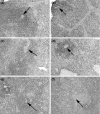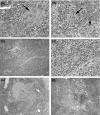Histopathology of spleen allograft rejection in miniature swine
- PMID: 15676033
- PMCID: PMC2517400
- DOI: 10.1111/j.0959-9673.2005.00414.x
Histopathology of spleen allograft rejection in miniature swine
Abstract
Spleen transplantation (SpTx) has established donor-specific tolerance in rodents, but not in large animals or humans. We report the histopathology of rejection in an established model of SpTx in major histocompatibility complex (MHC)-defined miniature swine. Of the 17 SpTx, rejection was observed in two grafts transplanted into untreated, MHC-matched, minor antigen-disparate recipients (group 1, n=4), but not in the two that received a 12-day course of cyclosporin A (CyA). Rejection also occurred in five grafts transplanted into fully MHC-disparate recipients (group 2, n=12), one of which was untreated and four of which received some form of immunosuppressive therapy. One recipient of an MHC class-I-mismatched spleen treated with 12 days of CyA did not show rejection. Following biopsy and/or necropsy, fixed allograft tissue sections were treated with multiple stains, immunohistochemical markers and TUNEL assay. Common features of rejection occurred in grafts from both groups, but with varying time courses. Necrosis developed as early as day 8 in group 2 and day 27 in group 1, ranging from focal fibrinoid necrosis of arteriolar walls and sinusoids to diffuse liquefactive necrosis, usually associated with haemorrhage. Other features of rejection included white pulp expansion by atypical cells and decreased staining of basement membranes and reticular fibres. A doubling of the baseline TUNEL index preceded histologically identifiable rejection. This study establishes histologic guidelines for diagnosing and, perhaps, in future studies, predicting acute rejection of splenic allografts transplanted across known histocompatibility barriers in a large-animal model.
Figures






References
-
- Bitter-Suermann H. Survival of unmodified spleen allografts in rats. Nature. 1974;247:465–466. - PubMed
-
- Booster MH, Wijnen RM, van Hooff JP, et al. The role of the spleen in pancreas transplantation. Transplantation. 1993;56:1098–1102. - PubMed
-
- Brigden ML, Pattullo AL. Prevention and management of overwhelming postsplenectomy infection – an update. Crit. Care. Med. 1999;27:836–842. - PubMed
-
- Dammin GJ, Wheeler HB, Montague ACW, Dealy JB, Greenberg JB, Moore FD. The splenic allograft: its course in the unmodified and modified canine recipient. Ann. N. Y. Acad. Sci. 1962;99:861–869. - PubMed
Publication types
MeSH terms
Grants and funding
LinkOut - more resources
Full Text Sources
Research Materials

